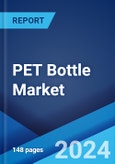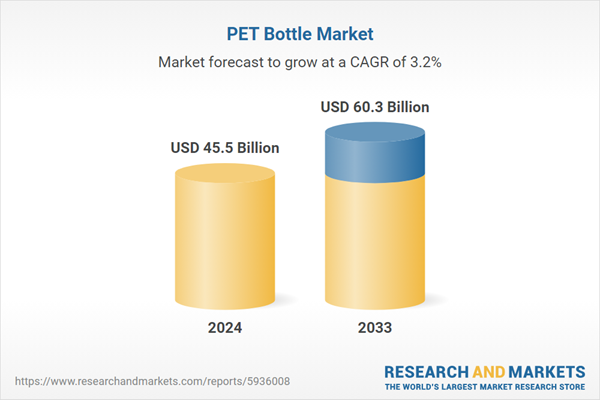The global PET bottle market size reached USD 45.50 Billion in 2024. Looking forward, the publisher expects the market to reach USD 60.30 Billion by 2033, exhibiting a growth rate (CAGR) of 3.2% during 2025-2033. The rising demand for PET bottles in the beverage industry, extensive product utilization in the personal care industries, and the growing environmental consciousness among the masses represent some of the key factors driving the market.
Competitive analysis such as market structure, market share by key players, player positioning, top winning strategies, competitive dashboard, and company evaluation quadrant has been covered in the report. Also, detailed profiles of all major companies have been provided. The market structure is fragmented with a number of small and large players operating in the industry due to low capital investments and barriers to entering the market. The volume of new entrants is high in the PET bottle industry on account of the low product differentiation.
What is a PET Bottle?
A PET bottle, also known as a polyethylene terephthalate bottle, is a plastic bottle commonly used for packaging beverages and other liquids. It is manufactured from a thermoplastic polymer resin that is produced by combining terephthalic acid and ethylene glycol. This polymer is known for its strong, lightweight, and durable properties, which make it an ideal material for creating bottles that are easy to transport and store. Additionally, it is also widely used as it is cost-effective and easy to manufacture. It is produced using a variety of methods, including injection molding, stretch blow molding, and extrusion blow molding. These manufacturing methods allow for the production of bottles in a wide range of sizes, shapes, and colors. Along with this, it is also recyclable as they can be melted down and reused to create new bottles, reducing waste and conserving resources.
2.What is the expected growth rate of the global PET bottle market during 2025-2033?
3.What are the key factors driving the global PET bottle market?
4.What has been the impact of COVID-19 on the global PET bottle market?
5.What is the breakup of global PET bottle market based on the capacity?
6.What is the breakup of the global PET bottle market based on the distribution channel?
7.What is the breakup of global PET bottle market based on the color?
8.What is the breakup of global PET bottle market based on the technology?
9.What is the breakup of global PET bottle market based on the end-use?
10.What are the key regions in the global PET bottle market?
11.Who are the key players/companies in the global PET bottle market?
Well-Diversified Applications of PET Bottles are Augmenting the Market Growth
PET bottles are used in a variety of industries, including food and beverage, healthcare, personal care, and household cleaning due to their versatility and flexibility. Since they can be molded into various shapes and sizes, and they are lightweight, shatterproof, and resistant to breakage, are raising the demand for PET bottles in various industries. For instance, the growing adoption of PET bottles in the healthcare industry to package pharmaceuticals, vitamins, and other healthcare products is significantly supporting the market. In addition, PET bottles are also utilized to package cleaning agents, such as detergents, bleach, and other cleaning products as they are resistant to chemicals and can withstand high temperatures, which is contributing to the market.Competitive analysis such as market structure, market share by key players, player positioning, top winning strategies, competitive dashboard, and company evaluation quadrant has been covered in the report. Also, detailed profiles of all major companies have been provided. The market structure is fragmented with a number of small and large players operating in the industry due to low capital investments and barriers to entering the market. The volume of new entrants is high in the PET bottle industry on account of the low product differentiation.
What is a PET Bottle?
A PET bottle, also known as a polyethylene terephthalate bottle, is a plastic bottle commonly used for packaging beverages and other liquids. It is manufactured from a thermoplastic polymer resin that is produced by combining terephthalic acid and ethylene glycol. This polymer is known for its strong, lightweight, and durable properties, which make it an ideal material for creating bottles that are easy to transport and store. Additionally, it is also widely used as it is cost-effective and easy to manufacture. It is produced using a variety of methods, including injection molding, stretch blow molding, and extrusion blow molding. These manufacturing methods allow for the production of bottles in a wide range of sizes, shapes, and colors. Along with this, it is also recyclable as they can be melted down and reused to create new bottles, reducing waste and conserving resources.
COVID-19 Impact:
COVID-19 has had a significant impact on the PET bottle sector, which is one of the largest sectors in the packaging industry. There has been an increase in demand for packaged goods, which has led to a rise in the uptake of PET bottles for packaging beverages, such as soft drinks, juices, and water, as well as household items, including cleaning agents and personal care products. However, due to the growing demand for these products has put immense pressure on PET bottle manufacturers to increase their production, resulting in supply chain disruptions and shortages of raw materials, such as PET resin and increase in the price level. Additionally, the temporary closure of manufacturing facilities and social distancing norms had negatively impacted the overall PET bottle market.PET Bottle Market Trends:
The escalating demand for PET bottles from the beverage industry majorly drives the global market. This can be supported by the widespread adoption of PET bottles for packaging water, carbonated drinks, juices, and other beverages. Along with this, the extensive product utilization in the personal care industry, for packaging products such as dressings, shampoos, and lotions is significantly supporting the market. With changing lifestyles and rapid urbanization, consumers are seeking convenient and on-the-go packaging options that can be easily carried and consumed. PET bottles, being lightweight and easy to handle, are becoming the preferred choice for such packaging solutions, which is propelling the demand. Apart from this, the rising environmental consciousness among the masses is creating a lucrative opportunity for PET bottles as they are recyclable and reusable. Furthermore, the development of new technologies for PET bottle production, such as lightweight and barrier technologies, are creating a positive market outlook. Some of the other factors driving the market include changing lifestyle patterns of the masses, the emerging e-commerce sector, and extensive research and development (R&D).Key Market Segmentation:
The publisher provides an analysis of the key trends in each sub-segment of the global PET bottle market report, along with forecasts at the global and regional level from 2025-2033. Our report has categorized the market based on capacity, color, technology, end-use and distribution channel.Capacity Insights:
- High
- Medium
- Low
Distribution Channel Insights:
- Business to Business
- Retail
- Supermarkets and hypermarkets
- Convenience Stores
- Online
- Others
Color Insights:
- Transparent
- Coloured
Technology Insights:
- Stretch Blow Molding
- Injection Molding
- Extrusion Blow Molding
- Thermoforming
- Others
End-Use Insights:
- Packaged Water
- Carbonated Soft Drinks
- Food Bottles & Jars
- Non-Food Bottles & Jars
- Fruit Juice
- Beer
- Others
Regional Insights:
- North America
- Asia Pacific
- Europe
- Latin America
- Middle East and Africa
Competitive Landscape:
The report has also provided a comprehensive analysis of the competitive landscape in the global PET bottle market.Some of the companies covered in the report include:
- Amcor Limited
- Cospack America Corporation
- BERICAP GmbH & Co. KG
- Rexam, Inc.
- Berry Global, Inc
- Graham Packaging Company Inc.
- Container Corporation of Canada
- Ontario Plastic Container Producers Ltd.
- Constar Internationals, Inc.
- Alpha Packaging
- Alpack Plastics
- Plastipak Holdings, Inc.
- Resilux NV
Key Questions Answered in This Report
1.What was the size of the global PET bottle market in 2024?2.What is the expected growth rate of the global PET bottle market during 2025-2033?
3.What are the key factors driving the global PET bottle market?
4.What has been the impact of COVID-19 on the global PET bottle market?
5.What is the breakup of global PET bottle market based on the capacity?
6.What is the breakup of the global PET bottle market based on the distribution channel?
7.What is the breakup of global PET bottle market based on the color?
8.What is the breakup of global PET bottle market based on the technology?
9.What is the breakup of global PET bottle market based on the end-use?
10.What are the key regions in the global PET bottle market?
11.Who are the key players/companies in the global PET bottle market?
Table of Contents
1 Preface3 Executive Summary18 Loans and Financial Assistance
2 Scope and Methodology
4 Introduction
5 Global PET Bottles Market
6 Market Breakup by Capacity
7 Market Breakup by Distribution Channel
8 Market Breakup by Color
9 Market Breakup by Technology
10 Market Breakup by End-Use
11 Market Breakup by Region
12 SWOT Analysis
13 Value Chain Analysis
14 Porter’s Five Forces Analysis
15 Price Analysis
16 PET Bottle Manufacturing Process
17 Project Details, Requirements and Costs Involved
19 Project Economics
20 Competitive Landscape
List of Figures
List of Tables
Companies Mentioned
- Amcor Limited
- Cospack America Corporation
- BERICAP GmbH & Co. KG
- Rexam Inc.
- Berry Global Inc
- Graham Packaging Company Inc.
- Container Corporation of Canada
- Ontario Plastic Container Producers Ltd.
- Constar Internationals Inc.
- Alpha Packaging
- Alpack Plastics
- Plastipak Holdings Inc.
- Resilux NV
Methodology

LOADING...
Table Information
| Report Attribute | Details |
|---|---|
| No. of Pages | 139 |
| Published | January 2025 |
| Forecast Period | 2024 - 2033 |
| Estimated Market Value ( USD | $ 45.5 Billion |
| Forecasted Market Value ( USD | $ 60.3 Billion |
| Compound Annual Growth Rate | 3.2% |
| Regions Covered | Global |
| No. of Companies Mentioned | 13 |









